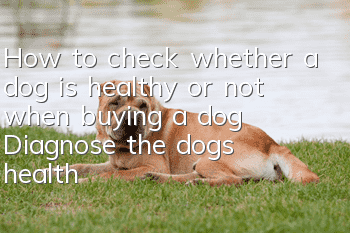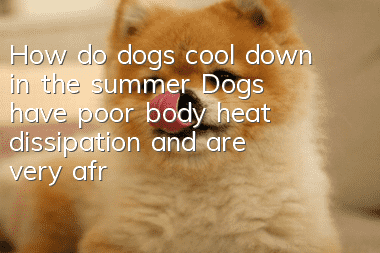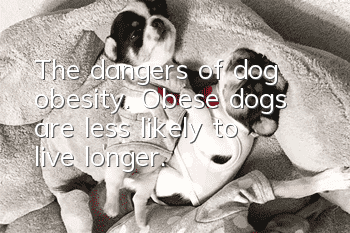How to check whether a dog is healthy or not when buying a dog? Diagnose the dog’s health from six aspects

Through mental state
Healthy dogs are lively and cute, energetic, agile, have bright eyes, and their ears often move with the sound, even if they are When sleeping, he remains alert all the time. When he hears the slightest movement, he will listen attentively and his eyes will stare in the direction of the movement, showing a very alert mental state.
If the dog has dull or half-closed eyes, is unwilling to move, prefers to lie still, has slow or unresponsive ears to external stimuli, has an indifferent expression, or is even in a lethargic state, these are all neurodepressive states. It is called depression or coma. Some sick dogs show excitement and restlessness, running around indoors and outdoors, panicking, screaming loudly, often walking aimlessly, turning in circles, and even biting various objects. This mental state is called mental excitement or mania. The above two mental states are abnormal mental manifestations.
By nutritional status
In order to determine the nutritional status of a dog, we mainly check the condition of fat and hair. A healthy dog should be slim, medium-sized, well-muscled, with smooth, smooth fur that is comfortable to see. If the dog's body is thin, its muscles are weak, its fur is rough and dull, dry, and its tail hair is upside down, it often suffers from parasitic diseases, skin diseases, chronic digestive tract diseases or certain infectious diseases.
ThroughPosture
When the dog is standing or walking, its limbs are restrained and does not dare to bear weight. , showing weakness in the limbs, indicates abnormalities in the limbs. If the dog's body is curled up when lying down, its head is placed under the abdomen, or it lies in an unnatural position and turns from time to time, it indicates abdominal pain.
By body temperature
Under normal living conditions, the body temperature of healthy dogs is maintained within a certain range, usually low in the morning and slightly higher in the afternoon. The temperature difference generally does not exceed 1`C. If it exceeds 1`C or is high in the morning and low in the afternoon, it indicates that the body temperature is abnormal. The normal body temperature of healthy dogs is: 38, 5`C~39`5C for puppies and 37`5C~38`5C for adult dogs. A simple way to determine a dog's fever is to analyze the dog's nose, ear base and mental state. A normal dog's nose is cool and moist, and the skin temperature at the base of the ears is the same as other parts. If you see that the end of the dog's nose (noscope) is dry and hot, the skin temperature at the base of the ears is higher than that of other parts, the dog is listless, has poor appetite and has increased thirst, it means that the dog has a high body temperature. In most infectious diseases, inflammation of the respiratory tract, digestive tract and other organs, and sunstroke and heat stroke, the body temperature rises. In poisoning, severe failure, malnutrition, anemia and other diseases, the body temperature often drops.
The most accurate way to measure body temperature is with a thermometer. When measuring temperature, the mercury column of the thermometer should be thrown below 35°C, wiped with alcohol cotton balls for disinfection, and apply a small amount of lubricant (liquid white wax). The dog should be kept in safe hands by an assistant. The thermometer should be slightly elevated and slowly inserted into the anus. After insertion, preventThe thermometer fell off. It can be taken out in 3 minutes and read in degrees. Rectal temperature will increase slightly when dogs are excited, nervous, and exercising.
Through breathing conditions
1. Respiratory conditions: The dog must be observed in a quiet state. Checking the respiratory status should include the number of breaths, breathing patterns and whether breathing is difficult.
(1) Breath count: Generally measured based on the ups and downs of the chest and abdomen. One breath is the rise and fall of the chest and abdomen. It can also be measured based on exhaled airflow in cold seasons. The respiratory rate of a healthy dog is 15 to 30 times per minute. The respiratory rate is often affected by certain physiological factors and external conditions. For example, the respiratory rate of puppies is slightly higher than that of adult dogs, and that of pregnant dogs is higher than that of non-pregnant bitches. Especially during exercise or excitement, the respiratory rate can often increase many times. In addition, changes in temperature and season can also affect changes in respiratory rate.
(2) Breathing style: The normal breathing style of dogs is chest breathing. If the abdominal wall moves more obviously than the chest wall during breathing (abdominal breathing) or the chest wall and abdominal wall move at the same time (thoracic-abdominal breathing), it indicates a disease in the chest or abdomen, such as pleurisy, pleural effusion, or rib fractures.
(3) Respiratory rhythm: Checking the dog's respiratory rhythm is also important for the diagnosis of respiratory diseases. The normal breathing of a healthy dog is an accurate and rhythmic alternating movement, that is, inhaling and exhaling. After each breath, there is a short interval, and then the next breath, so one cycle after another, very regular, It’s called rhythmic breathing. Arrhythmia is an abnormality. However, the breathing rhythm of healthy dogs will temporarily change due to excitement, exercise, fear, screaming, sniffing, etc., and should be distinguished from pathological changes. The frequency of pathology increases when pain, hypoxia, nerve excitation, and lung parenchymal lesions occur. The frequency decreases when toxic coma occurs. In encephalitis and toxemia, the frequency is fast and slow (tidal breathing).
When a sick dog opens its mouth, straightens its head and neck, moves its ribs upward and expands its elbows outward when breathing, it is dyspnea caused by airway obstruction. If the sick dog's breathing is shallow and the number of breaths increases, it indicates that the lungs cannot fully expand, which is common in rib fractures, pneumonia, pneumothorax or pleurisy. Difficulty breathing may also occur when the respiratory tract is compressed or blocked by foreign bodies or tumors and becomes narrowed.
2. Nasal secretions: There is almost no secretion from the nose of healthy dogs. When dogs have a cold or respiratory inflammation, secretions often flow from the nostrils. The nature of the secretions includes serous (clear nasal discharge), mucus, and when there is purulent inflammation, the nasal secretions can be purulent (purulent nasal discharge), or may be mixed with blood or fine foam. The amount of secretion often changes with the degree of inflammation. Sometimes no nasal secretions are seen, which may have been licked or wiped off by the dog. But when the condition is severe, he no longer licks his nostrils.
Look through the digestive system
(1) Oral examination: First check the color of the oral mucosa (oral color). Mouth colorChanges can alert us to many diseases and their severity. The normal color of a healthy dog's mouth is pink, with some areas having different pigments. Oral flushing refers to inflammation or increased body temperature; pallor refers to anemia; patients with liver and gallbladder diseases may appear yellow-red or yellow-white; patients with severe diseases may appear blue-purple (cyanosis), leading to blood circulation disorders or even shock. When checking the color of the mouth, pay attention to whether there is tongue coating and its color, tongue mobility, whether there are ulcers and injuries, etc. A healthy dog's mouth is moist and cannot flow naturally. If salivation occurs and viscous saliva flows from the corners of the mouth, indicating an increase in saliva, you need to check the color, gums, oral mucosa and pharynx for blisters, ulcers and swelling. Also look out for foreign objects or puncture wounds from sharp, hard objects, such as bone fragments.
(2) Observation of appetite: By observing appetite, diseases of the digestive system and some infectious or toxic diseases can be detected. Healthy dogs have a strong appetite and appetite, especially when their food contains a lot of fish and meat. Not only will they eat quickly, but they will also roar or even bite when other dogs approach to warn them not to approach. If you see a dog just sniffing it after feeding, wanting to eat but not eating or walking away, even if it is not interested in the food it usually likes to eat, or eating not much or not eating at all, it means that the dog has a loss of appetite or is disabled. , is a digestive tract disease or infection with certain infectious diseases or parasitic diseases. But pay attention to distinguish whether it is food refusal, picky eating, or difficulty eating. In addition, most dogs with high fever, diarrhea, and dehydration have a significantly increased desire to drink and an increased amount of water they drink. But in severe cases of circulatory failure, dogs will not drink water.
(3) Observation of vomiting: Dogs are animals prone to vomiting. Under normal circumstances, they may sometimes vomit. Therefore, attention should be paid to distinguishing and analyzing the causes of vomiting. If a large amount of stomach contents are vomited at one time but no more vomiting occurs within a short period of time, this is often caused by food. Vomiting is actually a protective response of the body. Therefore, when a dog is found to be vomiting, it should be carefully analyzed and distinguished based on the time and frequency of vomiting, the amount of vomit, the smell, and the nature and composition of the vomit. Frequent vomiting indicates that the gastric mucosa has been irritated for a long time, so it often occurs immediately after eating until the stomach contents are vomited; if it is caused by feed spoilage, the vomitus will contain food that has just been eaten. Fresh feed (rotten meat, etc.); the vomitus is brown or bright red, which is often caused by varying degrees of gastroenteritis or gastric ulcer; if the vomitus is a colorless liquid with foam, it is often caused by eating something on an empty stomach. Caused by various irritants; stubborn vomiting can occur even on an empty stomach, and is mostly caused by stubborn diseases of the stomach, duodenum, and pancreas (such as cancer). At this time, the vomitus is often mucus; such as Vomitus is mixed with roundworms, most of which are caused by excessive roundworm parasites. In addition, when force-feeding or force-feeding drugs can easily cause vomiting, please be careful.
(4) Defecation observation: Defecation observation should include defecation, defecation movements and frequency, defecation appearance, defecation volume, defecation odor and defecation color.
A. Defecation status:The dog's defecation posture is almost a squatting posture. If the normal defecation posture is not adopted and feces flows out of the anus involuntarily, it is common in persistent diarrhea, the later stages of certain intestinal infectious diseases, and lumbosacral spinal cord injury, which causes anal sphincter relaxation or paralysis. If the dog has frequent defecation movements, but no feces is discharged or only a small amount of mucus is discharged, this may be a symptom of rectal infarction. Therefore, the sick dog will appear restless, have pain, lose appetite or stop eating, and have a full abdomen with a large amount of gas. , must be treated promptly. For example, it is difficult to defecate, the feces is dry, hard, small, small in volume, dark in color, and has thick mucus or pseudomembrane on the surface. It is seen in the early stages of constipation, febrile venereal disease or mild gastroenteritis, etc. If the feces becomes loose and soft, the quantity increases, and there is undigested food mixed in the feces, it means that the dog's digestive function has declined. If the frequency of defecation increases and watery, porridge-like or mixed mucus, pus, blood, bubbles, etc. are discharged, these are the results of increased intestinal movement after intestinal stimulation, which is common in diseases such as enteritis. For adherent substances, attention should be paid to the location and nature of the adhesion, whether it is on the surface of the feces or in the feces. If there is bright red blood outside the feces, it is a sign of posterior intestinal bleeding; if the blood is evenly mixed in the feces and turns dark brown, it means that the bleeding site is in the stomach and front intestine. Of course, you should also pay attention to the smell of feces, whether it is foul, fishy or sour. Fecal parasite eggs should be checked if necessary.
B. Urination status: The urinating posture of male dogs is to lift one hind limb and then urinate to the side of the body; for female dogs, the hind limbs are slightly stepped forward, squatting slightly, arching the back and raising the tail to urinate. Urinary incontinence is often caused by bladder sphincter paralysis or lumbar spinal cord injury. Struggling to urinate and holding the hind limbs and abdomen on the cage net are symptoms of painful urination, which are mostly caused by cystitis, urethral stones or posthitis; decreased urine output and frequency are more common in acute nephritis, severe abdominal pain, shock and mental stress Exhaustion.
Through the above visual inspection, abnormal phenomena can be discovered and timely diagnosis and treatment can be carried out to prevent delays in the condition.
- What should you do if your dog loves to tear up the house? Your dog may have separation anxiety.
- Training your dog not to bite randomly - Notes on raising a good dog
- What to do if your dog doesn’t like wearing a collar? There are ways to wear a collar
- Can rabies be prevented? Rabies prevention and control technical guide
- The best age for golden retriever training to make your golden retriever a good baby
- Is it okay for dogs to eat leftovers? What are the effects of feeding leftovers to dogs?
- What do different dog postures mean? Understand the meaning behind the postures
- Do you know the distribution map of dogs in China?
- What do dogs pay attention to in spring? These things cannot be ignored
- Misunderstandings about raising dogs: These are the things you must know



